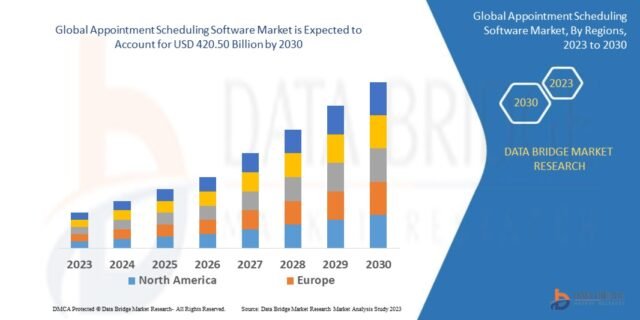Introduction
In today’s fast-paced business environment, efficient time management is crucial for success. Whether it’s a healthcare provider, a salon, a consulting firm, or an educational institution, managing appointments manually is no longer sustainable. This is where appointment scheduling software comes into play—a digital solution that automates booking, reduces no-shows, and enhances customer satisfaction.
The global appointment scheduling software market is experiencing rapid growth, driven by the increasing adoption of digital tools across industries. Businesses are recognizing the value of streamlined scheduling in improving operational efficiency and customer experience. From small local businesses to large enterprises, organizations are leveraging these tools to minimize administrative burdens and maximize productivity.
This guest post explores the evolution of appointment scheduling software, current market trends, key challenges, market scope, size, and factors driving growth. By understanding these dynamics, business owners, IT decision-makers, and service providers can make informed choices about implementing scheduling solutions.
Source: https://www.databridgemarketresearch.com/reports/global-appointment-scheduling-software-market
The Evolution of Appointment Scheduling Software
Appointment scheduling has come a long way from paper-based diaries and phone bookings. The journey of scheduling software can be traced through several key phases:
1. Manual Scheduling (Pre-2000s)
Businesses relied on physical appointment books, spreadsheets, and phone calls to manage bookings. This method was time-consuming, prone to errors, and lacked flexibility.
2. Early Digital Solutions (2000-2010)
The rise of the internet introduced basic online booking systems. These tools allowed customers to book appointments via websites but had limited automation and integration capabilities.
3. Cloud-Based Scheduling (2010-2020)
The shift to cloud computing revolutionized scheduling software. Platforms like Calendly, Acuity Scheduling, and Booker emerged, offering:
- 24/7 online booking
- Calendar synchronization (Google Calendar, Outlook)
- Automated reminders (SMS & email)
- Multi-user access for teams
4. AI-Powered & Integrated Scheduling (2020-Present)
Modern scheduling software now incorporates:
- AI-driven scheduling assistants (e.g., chatbots, voice assistants)
- Seamless CRM & payment integrations (Salesforce, Stripe)
- Predictive analytics to optimize booking slots
- Hybrid scheduling (in-person + virtual appointments)
Today, appointment scheduling software is not just a convenience—it’s a business necessity, enabling companies to operate more efficiently and deliver superior customer experiences.
Current Market Trends
The appointment scheduling software market is evolving with several emerging trends:
1. Rise of AI and Automation
AI-powered tools now handle smart scheduling, rescheduling, and no-show predictions, reducing manual intervention. Chatbots and virtual assistants enable instant bookings via messaging apps.
2. Integration with Business Ecosystems
Scheduling software is increasingly being embedded into:
- CRM systems (HubSpot, Zoho)
- Telehealth platforms (for healthcare providers)
- POS systems (retail & hospitality)
- Video conferencing tools (Zoom, Microsoft Teams)
3. Mobile-First Scheduling
With 80% of customers using smartphones to book services, mobile-optimized scheduling apps are becoming essential. Features like one-click bookings and wallet integrations enhance convenience.
4. Subscription & Membership-Based Models
Businesses are adopting recurring appointment models (e.g., fitness classes, therapy sessions), driving demand for subscription-aware scheduling tools.
5. Focus on No-Show Reduction
Advanced features like automated reminders, prepayments, and cancellation policies help minimize missed appointments, improving revenue retention.
Key Challenges in the Market
Despite its growth, the appointment scheduling software market faces several hurdles:
1. Data Security & Privacy Concerns
Handling sensitive customer data (e.g., medical appointments) requires HIPAA/GDPR compliance, which some vendors struggle to meet.
2. High Competition & Market Saturation
With hundreds of scheduling tools available, differentiation is challenging. Smaller vendors must innovate to compete with established players.
3. Resistance to Digital Adoption
Some traditional businesses (e.g., local salons, clinics) still prefer manual scheduling due to lack of tech awareness or budget constraints.
4. Integration Complexities
Not all scheduling tools seamlessly integrate with legacy systems, creating workflow disruptions for enterprises.
Market Scope and Segmentation
The appointment scheduling software market can be segmented by:
By Deployment Mode:
- Cloud-Based (Dominates due to scalability & affordability)
- On-Premises (Preferred by industries with strict data control needs)
By Organization Size:
- Small & Medium Businesses (SMBs) (Largest adopters for cost efficiency)
- Large Enterprises (Need advanced features & enterprise integrations)
By Industry Vertical:
- Healthcare (Telemedicine drives demand)
- Beauty & Wellness (Salons, spas, fitness centers)
- Education (Tutoring, career counseling)
- Professional Services (Legal, financial consulting)
By Region:
- North America (Largest market due to tech adoption)
- Europe (Growing with GDPR-compliant solutions)
- Asia-Pacific (Fastest growth via SMB digitalization)
Market Size and Factors Driving Growth
The global appointment scheduling software market is projected to grow at a CAGR of 14-18% through 2030, fueled by:
1. Post-Pandemic Digital Acceleration
The shift to remote and hybrid service models (e.g., telehealth, virtual consulting) has permanently increased demand.
2. Customer Experience (CX) Focus
Businesses are prioritizing frictionless booking experiences to retain clients in competitive markets.
3. Rise of Gig Economy & Freelancers
Independent professionals (coaches, therapists, tutors) need affordable self-booking tools.
4. Government & Healthcare Digitization
Public sector adoption (e.g., vaccine scheduling, DMV appointments) is expanding market reach.
5. Smart City Initiatives
Urban digitization projects are incorporating automated scheduling for public services.
Conclusion
The appointment scheduling software market is no longer just about replacing paper calendars—it’s a strategic tool driving operational efficiency, customer satisfaction, and revenue growth. As AI, mobile tech, and ecosystem integrations advance, these platforms will become even more intelligent and indispensable.
While challenges like data security and adoption barriers persist, the long-term outlook remains strong. Businesses that embrace next-gen scheduling solutions today will gain a competitive edge in the experience-driven economy of tomorrow.







